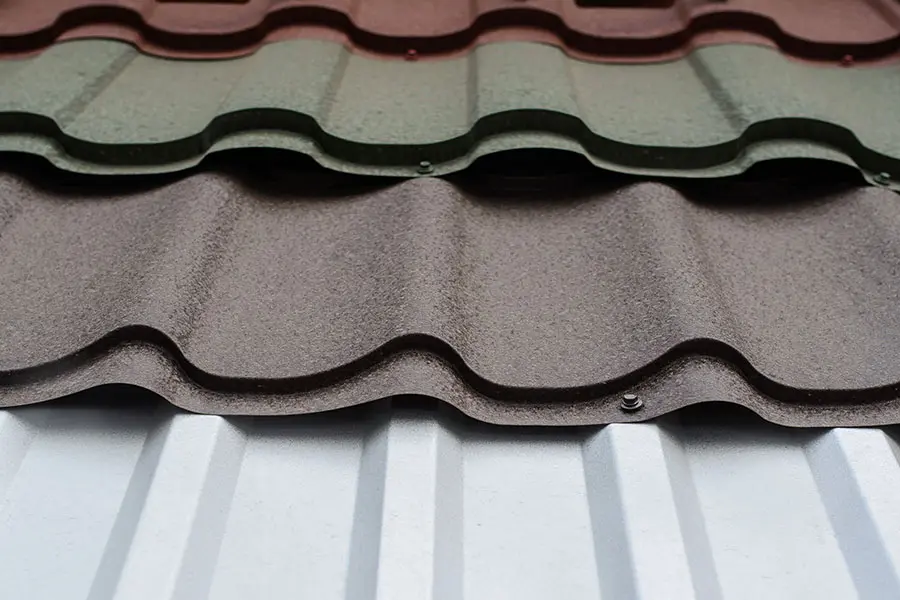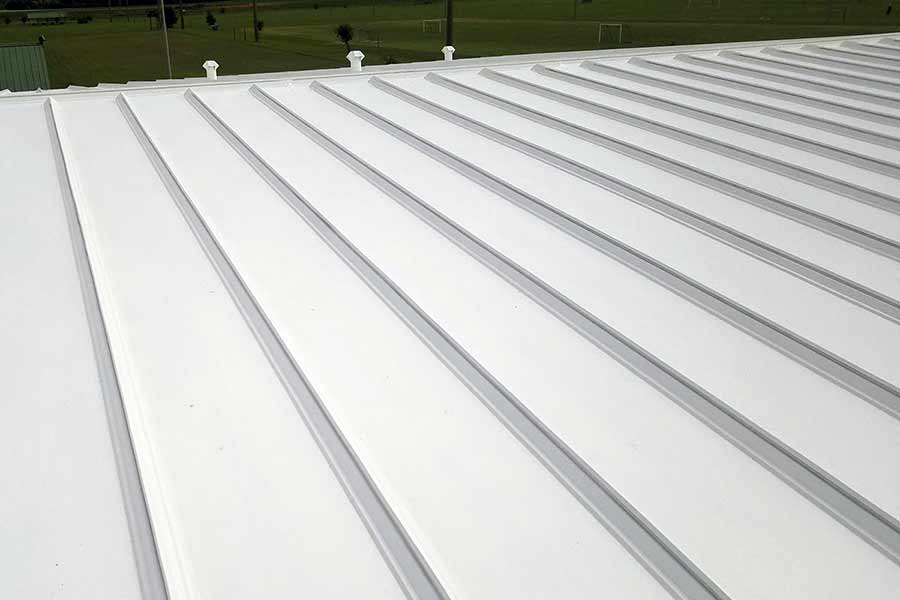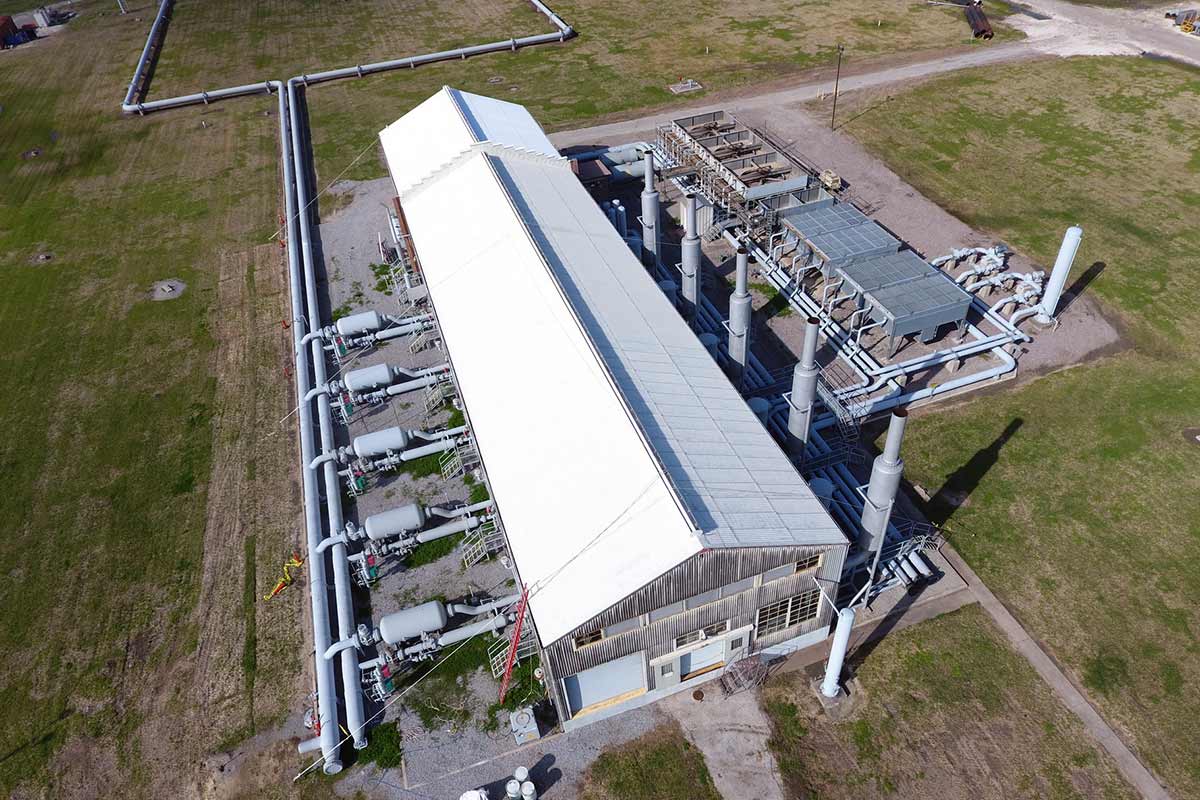
Choosing suitable roofing materials is critical when constructing or renovating commercial buildings. With its blend of durability, energy efficiency, and aesthetic versatility, metal roofing stands out among the materials available today. This comprehensive guide is designed to help you navigate the types of metal roofs available, aiding in an informed decision that aligns with your project’s needs. Understanding each type’s unique advantages and applications allows you to select a roofing solution that meets and exceeds your expectations.
Table of Contents
Attention! Are you interested in learning more about different types of metal roofs? Click here to speak with an American WeatherStar Approved Contractor.
Understanding Metal Roofing
The journey of metal roofing from its industrial roots to becoming a preferred material for commercial buildings is a fascinating story of innovation and resilience. Initially favored for its durability and protective qualities in factory settings, metal roofing has evolved, embracing advancements in materials science and design to meet the diverse needs of modern architecture. This transformation is a testament to metal roofing’s adaptability and enduring benefits for all types of metal roofs.
The Evolution of Metal Roofing
Metal roofing’s history spans centuries, with early uses dating back to protective coverings on medieval castles. Over time, it has adapted to architectural trends and technological advancements, leading to the variety of metal roof types and styles we see today. Modern metal roofs are about protection, aesthetic appeal, energy efficiency, and environmental sustainability.
Why Metal Roofing Stands Out
Metal roofs are appealing for a multitude of reasons:
- Durability and Protection: They are built to withstand extreme weather conditions, from heavy snowfall to high winds and hail, ensuring long-term protection for commercial buildings consisting of different types of metal roofing.
- Energy Efficiency: Metal roofs reflect solar radiant heat instead of absorbing it, contributing to lower cooling costs and energy savings. This reflective capability and insulation options can significantly reduce a building's carbon footprint. Additionally, applying specialized metal roof coatings can enhance this reflectivity, improving energy efficiency by minimizing heat gain and offering added protection against the elements.
- Aesthetic Versatility: The array of metal roof styles allows unparalleled design flexibility. A metal roofing option suits every architectural vision, aiming for a sleek, contemporary look or a traditional appearance for all metal roof types.
- Longevity: With proper installation and maintenance, metal roofs can last 50 years, far exceeding traditional roofing materials like asphalt shingles.
Key Considerations in Selecting Metal Roofing
When choosing the right type of metal roof, several critical factors need to be considered:
- Geographic Location: The local climate and environmental conditions can influence the choice of material and style for different types of metal roofing. Areas prone to hurricanes, for example, may benefit from specific metal roofing systems' strength and wind resistance.
- Architectural Style: The building's aesthetic and structural design should align with the chosen roofing material and style, ensuring a cohesive and attractive appearance.
- Budget Constraints: While metal roofing is a cost-effective choice in the long run due to its durability and energy savings, initial costs can vary widely based on material and design complexity. Balancing upfront costs with long-term benefits is crucial for all metal roof types.
- Environmental Impact: For projects prioritizing sustainability, the recyclability and energy efficiency of different metal roofing materials can be a deciding factor.
Navigating the options can be daunting, given the various types of metal roofing available in the market. We aim to demystify these choices, providing clear, comprehensive guidance to help you identify the optimal roofing solution for your commercial building. By understanding the historical context, benefits, and critical considerations of metal roofing, stakeholders can make informed decisions that align with their architectural vision, functional requirements, and budgetary constraints.
Recommended Reading: Commercial Metal Roofing: 15 Things to Consider
Types of Metal Roofing Materials
Selecting a suitable material is a foundational step in choosing a metal roofing system. Each material offers distinct advantages, making it ideal for various applications and architectural styles. Let’s explore the specifics of each option of all the different types of metal roofs.
Aluminum
Aluminum’s standout feature is its corrosion resistance, making it an excellent choice for coastal regions where salt spray is a concern compared to other metal roof types. Lightweight yet strong, aluminum roofing is easy to install and can be shaped to fit a variety of roof designs. Its reflective properties contribute to energy efficiency by keeping buildings cooler in the summer. Furthermore, aluminum is fully recyclable, enhancing its appeal for eco-conscious projects. Despite its higher initial cost than some other metals, its longevity and low maintenance needs make aluminum a cost-effective choice for the roof’s life.

Steel
Steel, one of the most common materials for metal roofing, is favored for its strength, durability, and economic efficiency compared to other types of metal roofing. It’s available in several alloys and coatings to suit different environments and aesthetic preferences:

Copper
Copper roofing offers a unique blend of natural beauty and exceptional durability. Over time, it develops a green patina that contributes to its aesthetic appeal and increases its resistance to corrosion. Copper is extremely long-lasting, with roofs lasting over a century in some cases. It’s also highly resistant to fire, hail, and mildew. While copper is among the most expensive metal roofing materials of all metal roof types, its longevity and distinct look can significantly enhance a building’s value and appeal.

Zinc
Zinc roofing stands out for its environmental friendliness and minimal maintenance requirements. It has a self-healing ability, where scratches and imperfections can gradually blend into the material, maintaining a fresh appearance. Zinc’s low melting point reduces energy consumption during production, and its 100% recyclability at the end of its life contributes to its sustainable profile. Like copper, zinc develops a protective patina that shields it from corrosion, making it an excellent choice for buildings in various climates.

Metal Roof Types and Styles
The realm of metal roofing is vast and varied, encompassing many styles that can accommodate virtually any architectural vision or functional requirement. Each style offers unique aesthetic appeal and specific durability, maintenance, and installation benefits. Let’s explore these options in greater depth.
Standing Seam Metal Roofs
Standing seam metal roofs are distinguished by their raised seams that extend vertically along the roof’s length, well above the level of the roofing panel. This design significantly enhances leak resistance by minimizing the number of seams exposed to the elements. Additionally, the hidden fastener system used in standing seam roofs eliminates the risk of water infiltration through screw holes, making it an excellent choice for regions prone to heavy rain or snow over other metal roof types. Available in various materials, including aluminum, steel, and copper, standing seam metal roofs offer a sleek, contemporary look while providing exceptional durability and performance.
Metal Shingles and Tiles
Metal shingles and tiles replicate the appearance of traditional roofing materials such as wood shakes, slate, or clay tiles, combining classic aesthetics with the inherent advantages of metal. This option allows building owners to achieve the desired look without compromising longevity or resistance to fire, wind, and impact. Metal shingles are lightweight, making them suitable for a wide range of structures, and they come in numerous colors and textures to fit any architectural style. Furthermore, they provide an energy-efficient roofing solution, reflecting solar radiant heat and reducing cooling costs.
- Galvanized Steel is coated with zinc to protect against rust. It's a popular choice for its balance of durability and cost-effectiveness, and it is ideal for a wide range of commercial buildings.
- Galvalume Steel combines zinc and aluminum coating to offer enhanced corrosion resistance. It is particularly suitable for areas with a mix of wet and dry conditions.
- Weathering Steel (Corten) is designed to develop a stable rust-like appearance when exposed to the weather, protecting against further corrosion. It's best used in architectural applications where the rustic appearance is desired and can be allowed to weather naturally.
Corrugated Metal Roofs
Corrugated metal roofing, with its characteristic rippled surface, is known for its strength and durability. The corrugation process increases the tensile strength of the metal, enabling it to withstand heavy loads and severe weather conditions. This type of roofing is highly cost-effective, offering a long lifespan with minimal maintenance requirements. Corrugated metal roofs are versatile enough to suit modern and traditional commercial buildings, providing a practical yet aesthetically pleasing roofing solution.
Ribbed Metal Panels
Ribbed metal panels feature a series of high ridges and low valleys, creating a pattern that adds texture and dimension to the roof’s surface. Similar to corrugated metal but with a more pronounced profile, these panels are available in exposed and concealed fastener configurations. Ribbed metal panels can be used in various applications, from commercial and industrial buildings to agricultural structures. They offer excellent durability, weather resistance, and the added benefit of quick and easy installation.
Architectural and Structural Metal Panel Systems
Architectural metal panel systems are designed for visually demanding applications where aesthetic appeal is as important as performance. These panels offer a smooth, modern façade and are available in various finishes and materials, including aluminum composite materials (ACM) and coated metals. On the other hand, structural metal panels are engineered to provide load-bearing capabilities and serve as a weather-tight roof or wall covering. Both systems allow creative design flexibility, enabling architects and builders to realize distinctive and innovative building envelopes.
Exposed Fastener Panels vs. Concealed Fastener Panels
The choice between exposed and concealed fastener panels hinges on aesthetic preferences and performance requirements. Exposed fastener systems are more traditional and cost-effective, making them popular for industrial and commercial applications over other metal roof types. However, concealed fastener panels are preferred for a cleaner look and enhanced weather resistance. These systems hide the fasteners from view, creating a smooth, uninterrupted surface that elevates the building’s overall aesthetic while minimizing the potential for leaks.
Maintenance and Longevity for Different Metal Roof Types
Understanding metal roofing materials maintenance requirements and longevity is crucial for property owners looking to maximize their roofing investment. Different metal roofs have varying maintenance needs and lifespans, and adopting regular maintenance practices is vital to extending a roof’s life. This section outlines essential maintenance strategies and offers insights into the expected longevity of popular metal roofing materials.
Recommended Reading: 5 Common Causes of Metal Roof Leaks & Repair Options
Essential Maintenance Practices
Maintaining a metal roof’s longevity and performance requires a commitment to regular care. While different metal roof types are celebrated for their durability and minimal upkeep, specific practices can significantly impact their lifespan and functionality. Below are key maintenance activities that play a pivotal role in preserving the condition of your metal roofing:
- Cleaning: Debris, leaves, and other deposits can accumulate on metal roofs, potentially holding moisture against the roof and leading to corrosion over time. A routine cleaning schedule helps maintain the roof's integrity and appearance. More frequent cleaning may be necessary for areas with high pollution or organic growth for all types of metal roofing.
- Inspections: Professional inspections are recommended at least once a year to identify potential issues like sealant failures, rust spots, or mechanical damage. Early detection and repair of such issues can prevent more significant problems.
- Preventative Measures include applying protective coatings where applicable, ensuring proper gutter function to prevent water accumulation, and removing overhanging branches that may scratch or damage the roof surface.
Lifespan Expectation by Material
The durability of all metal roof types is one of its most significant advantages, providing a long-term roofing solution for commercial properties. However, the expected lifespan of metal roofing varies depending on the material used. Understanding these differences between different types of metal roofing can help property owners make informed decisions tailored to their needs and environmental conditions. Here’s a closer look at how different materials stack up in terms of longevity:
- Aluminum and Steel: Generally, aluminum and steel roofs can last 40 to 70 years. The specific lifespan often depends on the coating used (such as galvanized or Galvalume for steel) and environmental conditions. Regular maintenance plays a critical role in achieving the upper range of this lifespan.
- Copper and Zinc: Copper and zinc roofs can exceed 100 years, gradually developing a protective patina that shields the metal from corrosion. Their durability makes them an excellent long-term investment over other metal roof types for any commercial property.
Cost Analysis and Installation
Understanding the cost implications and installation specifics is essential when considering metal roofing for commercial buildings. This overview highlights key financial considerations and what to expect during installation, offering a more straightforward pathway to informed decision-making on different types of metal roofing.
Evaluating the Financial Aspect
Several factors, including the choice of material and the complexity of the roofing design, influence the initial cost of metal roofing. While higher upfront than traditional options, metal roofing’s longevity and energy efficiency provide substantial savings over time.
- Material Selection: Costs vary widely between different metal roof types, with aluminum and steel on the lower end and copper and zinc being premium options.
- Design Complexity: The architectural design of the roof can affect installation difficulty and, consequently, the cost. Custom cuts and designs may require additional labor and materials.
Understanding Installation Process
The successful installation of a metal roof relies on precision and expertise from start to finish. This involves several critical steps:
- Preparation: This includes stripping the old roof, if necessary, and preparing the substrate for metal roofing. Proper insulation and underlayment are applied to enhance performance for all metal roof types.
- Installation Techniques: Installation techniques will vary depending on the metal roofing type chosen. Standing seam roofs may require specialized tools for seam formation, whereas modular metal tiles or shingles have different fitting and fastening requirements.
- Expertise Required: The complexity of metal roofing installation underscores the importance of selecting a contractor with specific experience in metal roofs to ensure quality and durability.
By partnering with a knowledgeable contractor and understanding the comprehensive cost benefits, commercial property owners can confidently navigate the metal roofing process, ensuring a long-term roofing solution that meets both budgetary and aesthetic goals when considering different types of metal roofing for your commercial property.
Metal Roof Types: Frequently Asked Questions
The main benefits of choosing metal roof types for commercial buildings include their superior durability, energy efficiency, and versatile aesthetics. They are designed to withstand severe weather, reduce cooling costs, and offer a range of styles to enhance building design.
Depending on the type of metal roof, lifespans can vary significantly. Aluminum and steel roofs generally last 40 to 70 years, whereas copper and zinc roofs can last well over 100 years, especially with regular maintenance and favorable environmental conditions.
Initially, metal roof types may present a higher upfront cost compared to traditional roofing materials. However, considering their extended lifespan, lower maintenance needs, and potential energy savings, they are often more cost-effective in the long run.
Yes, various types of metal roofs can be adapted to fit almost any commercial building design and roof slope. Professional installation is key to ensuring that the specific roofing type is correctly matched and applied to your building’s requirements.
Metal roof types are highly reflective, helping to reduce heat absorption and potentially lowering cooling costs during warmer months. The specific energy efficiency benefits can vary based on the metal type and the color or finish of the roofing material.
While metal roof types are known for low maintenance, some care is needed to maximize their lifespan. This includes regular debris removal, periodic inspections to identify and address any damage or wear, and specific care for different metal materials to prevent corrosion.
Selecting the right metal roof type involves considering your building’s architectural style, the local climate, budget, and environmental sustainability goals. It’s also crucial to consult with experienced metal roofing professionals who can provide insights tailored to your project’s unique needs.
Click here to schedule a free roof inspection with an American WeatherStar Approved Contractor.
Mixing different types of metal roofs can be done for aesthetic or functional reasons. Still, it requires careful planning to ensure compatibility in terms of expansion and contraction, color matching, and overall design coherence. Professional advice is essential in these cases to achieve the best outcome.
Conclusion
With its durability, energy efficiency, and style versatility, metal roofing is a compelling choice for commercial buildings. This expanded guide aims to equip readers with the knowledge to choose the best metal roofing type for their projects, considering both aesthetic and functional requirements, sustainability, and cost-effectiveness.
By delving into the specifics of each roofing material, exploring real-world applications, and discussing maintenance and cost factors, we hope to thoroughly understand metal roofing’s benefits and applications of all types of metal roofing. This comprehensive approach ensures that your commercial building is protected, visually appealing, and environmentally responsible.
If you’re interested in learning more about different types of metal roofing and which is best for your property, schedule a free roof inspection with an American WeatherStar-approved Contractor today.
Related Posts
Commercial Metal Roofing: 15 Things To Consider
When choosing a roofing solution for commercial properties, one option stands out as a symbol of strength, durability, and aesthetic appeal -…
What Is the Best Metal Roof Coating?
Metal roof coatings provide many benefits. They do more than just stop leaks—they reduce energy consumption, prevent rust and corrosion, lower…
Measuring Metal Roof Profiles to Determine Stretch Factor
In this edition of Tech Talk, Eric demonstrates how to determine stretch factor on a metal roof. Stretch factor has to be taken into…























